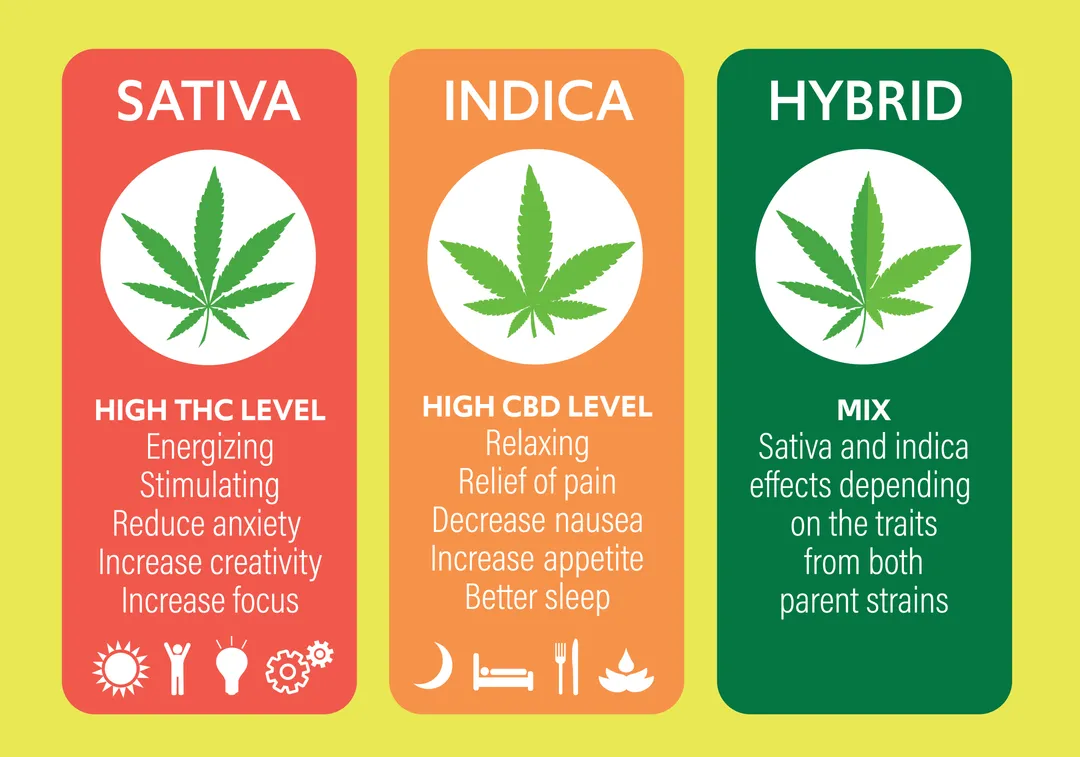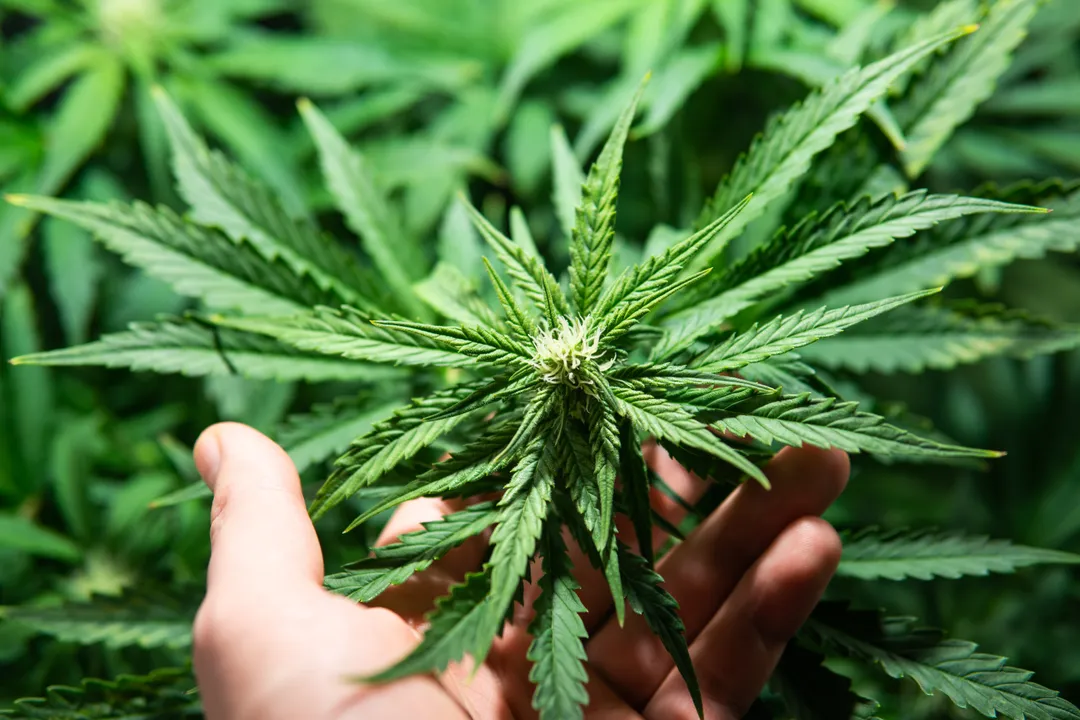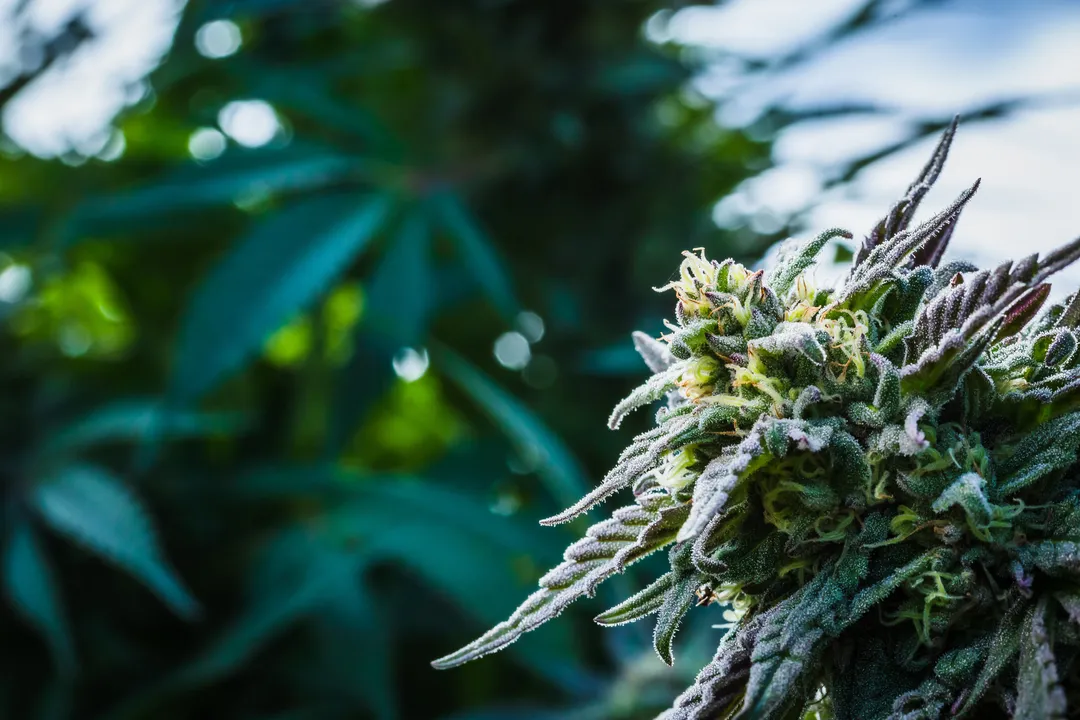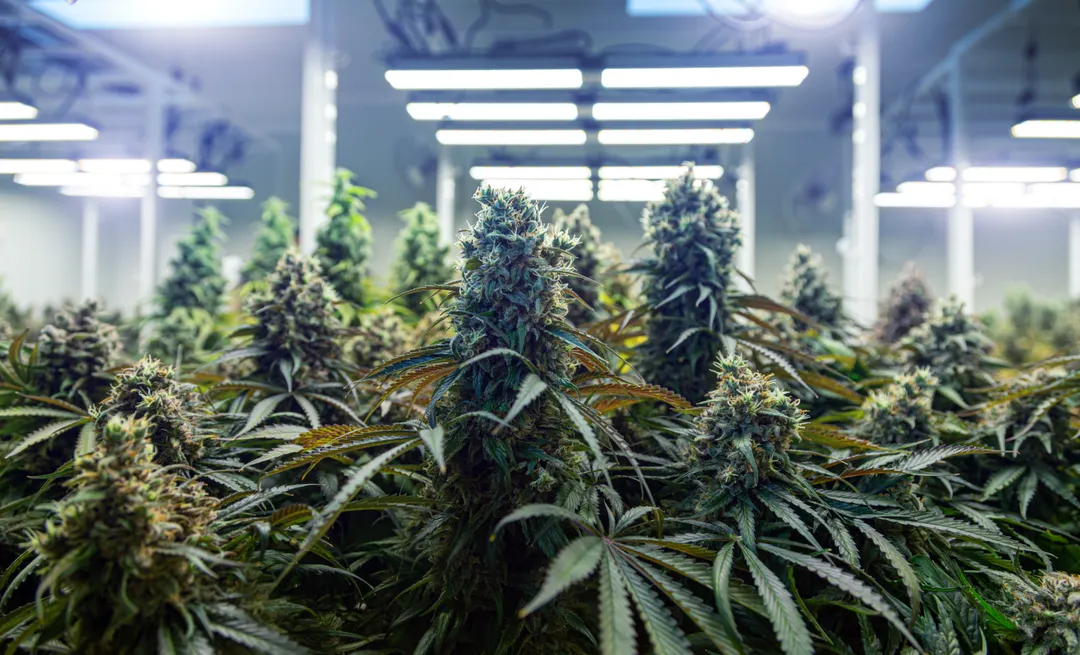
March 11, 2024
Indica vs. Sativa vs. Hybrid - Difference, Effects, Use
Table of Contents
If you're new to cannabis, the terms "Sativa," "Indica," and "Hybrid" probably make you scratch your head in confusion. What do they mean, and why do they matter?
As it turns out, whether your cannabis product is Indica, Sativa, or Hybrid can make all the difference in your overall experience. So, we're going to cover everything there is to know about the distinct effects and properties of these variants so you can determine which is right for you. Let's get started!
Species of Cannabis

First, we'll talk about the various species of cannabis.
Well, we'll talk about if there are different species of cannabis. Currently, there are three putative species of cannabis which includes:
- Cannabis sativa
- Cannabis indica
- Cannabis rudaralis
Visually, you can tell these three species apart based on their seeds, shape, and size. However, there are other differences to note as well. And yes, we used the word "putative," meaning "generally considered to be."
The truth is that we don't know if they're all different species or just variations of the same one. For instance, in 2021, several scientists analyzed over 100 cannabis samples and found that they were genetically indistinct on a genome-wide scale.
Instead, they found that the labeling had to do more with a variation of terpenes. Terpenes are aromatic compounds found in all sorts of plants, including cannabis. A plant's terpene profile can determine its taste, but there is also speculation that terpenes can act synergistically with cannabinoids.
For example, preliminary research has found that myrcene (also found in hops, lemongrass, and basil) helps cannabinoids cross the blood-brain barrier. But let's dive a bit more into these main cannabis variants.
Sativa

Originating from Eastern Asia, Cannabis sativa was first classified by Carl Linnaeus, the "father of modern taxonomy," in 1753.
The word "sativa" is Latin for "things that are cultivated."
In its appearance alone, Sativa tends to be taller and narrower than Indica or Ruderalis. Compared to different cannabis variants, the "fingers" on the leaves of a sativa plant tend to be thinner.
And if you've read the 2018 Farm Bill (it's quite the page-turner), you will notice that the definition of hemp is:
...Cannabis sativa L. and any part of that plant, including the seeds thereof and all derivatives, extracts, cannabinoids, isomers, acids, salts, and salts of isomers, whether growing or not, with a delta-9 tetrahydrocannabinol concentration of not more than 0.3 percent on a dry weight basis.
Yup. Hemp, by law, is Cannabis sativa. But don't fret if you're enjoying Indica hemp. In U.S. Code, marijuana is defined as Cannabis sativa as well. It's just the concentration of Delta-9 THC that matters.
Sativa Terpene Profile & Properties
Cannabis that falls under the Sativa category will have a higher concentration of pinene and limonene.
Pinene is also found in conifers, aka "pine trees." This terpene gives cannabis its woodsy taste and smell.
Limonene is a terpene found in the peels of citrus fruits and many other plants. It's what gives many cannabis strains their citrusy hints.
Many cannabis enthusiasts have found Sativas perfect as their go-to option for daytime enjoyment. Some have described this species as having a heavier emphasis on uplifting and energetic effects, but keep in mind that cannabis affects us all a bit differently.
An “absolute” rendition of this profile can be found in our Sativa Live Rosin Gummies
Sativa Strains
Within the Sativa category are specific strains. Some of these strains may lean closer to hybrid, others more towards an "absolute Sativa," and others in between. Their terpene profiles are generally very similar to one another with some nuances.
Hemp strains are simply marijuana strains crossbred to have a Farm Bill-compliant concentration of Delta-9 THC. They have the same defining terpene profile but differ only in one cannabinoid.
A few of the most well-known and beloved sativa strains include:
- Blue Dream
- Sour Diesel
- Maui Wowie
- Trainwreck
- Strawberry Cough
And that about covers Sativa, which brings us to our next category—Indica.
Indica

Cannabis indica was first classified in 1785 by French naturalist Jean-Baptiste Lamarck.
"Indica" is Latin for "of India."
That's because this variant of cannabis originates from, you guessed it, India, specifically near the mountain range known as the Hindu Kush.
Kush? That name kind of rings a bell.
In appearance, Indica plants tend to be shorter and bulkier. Even the fingers on its leaves are much thicker than that of sativa.
Indica Terpene Profile and Properties
Many cannabis plants that fall into Indica have heavier concentrations of myrcene and beta-caryophyllene.
Myrcene can be found in lemongrass, hops, and thyme. It's what gives cannabis its musky, earthy, and spicy undertones.
Beta-caryophyllene is in plants such as black pepper, cinnamon, cloves, and oregano. This terpene is known for its spicy, warm, and peppery flavor. Some have attributed to it the "gassy" aroma of many cannabis strains.
Indicas are generally the choice of connoisseurs for nighttime enjoyment. For many, this variant's effects are heavier on the relaxation and tranquility side. However, be aware that cannabis products affect everyone a bit differently.
Our Indica Live Rosin Gummies feature an “absolute” indica terpene profile.
Indica Strains
Much like Cannabis Sativa, farmers have bred indica strains into Farm Bill-compliant hemp. These strains have the same terpene profiles as their marijuana counterparts but have a 0.3% or lower concentration of Delta-9 THC by dry weight.
Some notable Indica strains include:
- Northern Lights
- Hindu Kush
- Granddaddy Purple
- Afghani
- Blueberry
And now, before we get to hybrids, we'll talk about a less-talked-about cannabis variant— ruderalis.
Ruderalis

Almost everyone and their mother has heard of Cannabis indica and Cannabis sativa. So why isn't Cannabis ruderalis such a household name?
Cannabis ruderalis was first classified by botanist D.E. Janischewsky in 1924. Its native range spans from Central to Eastern Europe as well as Russia.
In botanical nomenclature, "ruderalis" roughly means “growing among rubble." Humans have cultivated Ruderalis, but this subset is generally more or so feral.
Cannabis ruderalis is much smaller in stature than its sativa and indica relatives, rarely growing over two feet. Its leaves are also thick but with fewer fingers.
On a commercial level, there hasn’t been a direct niche that Ruderalis can fill. It does contain high amounts of CBD, but with its small stature, farmers are more likely to just go with Sativa or Indica hemp variants. And because it lacks THC potency, farmers don’t really cultivate it as marijuana either.
However, it hasn’t been completely ignored as a cash crop. Ruderalis, with its "weedy" nature, is quite a tough little plant.
Unlike other cannabis variants, Ruderalis enters its flowering cycle based on its maturity rather than the light cycle (the cycle of light and darkness a plant receives). So regardless of lighting conditions, it will still flower. Because of this auto-flowering trait, many have bred Ruderalis into Sativa and Indica strains to bolster them with the robustness of this variant.
And besides that, that's just about what you need to know about Ruderalis. However, with all this talk about breeding, let’s move on to Hybrids.
Hybrids
When we talk about Sativas, Indicas, and Ruderalis, we're talking about distinct plant types, their appearance, cannabinoid content, and terpene profiles.
"Hybrid" is a blanket term that can describe many different cannabis plants. It's pretty much a strain that comes about when crossing any of the main variants.
The exciting part about Hybrids is that they can bring in more variety for cannabis enthusiasts. For example, you can have "absolute" hybrids that are dead in the middle of Sativas and Indicas as far as traits go.
However, you can also have Hybrids that might skew slightly one way or another. The Gelato strain, for example, is a strain considered to be an "Indica-leaning" Hybrid. However, our Hybrid Live Rosin Gummies will feature a perfectly balanced profile directly between Indica and Sativa.
Some notable strains of Hybrid strains include:
- Gelato
- Wedding Cake
- Orange Creamsicle
- White Widow
- Strawberry Banana
Differences Between Cannabis Strains
You have the main subsets of cannabis, and then within those groups are strains. So what are the differences between cannabis strains?
It’s going to be similar to the difference between Indica and Sativa or other types.
In general, cannabis strains may differ based on appearance. However, from an experiential perspective, what will set them apart is their terpene profile.
Terpenes give strains their flavor and may have a synergistic effect with cannabinoids. However, things get a bit more complex when you talk about “differences” in effects. So let’s jump into that next.
Possible Effects and Side Effects
The consensus among enthusiasts is that Sativas are more uplifting while Indicas are more relaxing, and Hybrids can offer a little bit of both.
However, the truth is that the effects of any cannabis product will vary from person to person. And then, there are a bit more complicated nuances beyond that as well.
The constant factor of subsets and strains is their terpene profile, which can offer synergy when paired with cannabinoids. Nonetheless, determining the effects will depend on which cannabinoid it's paired with. For example, smoking a Gelato marijuana flower will yield different outcomes compared to smoking a Gelato hemp flower.
That's because the primary cannabinoid in one is Delta-9 THC while in the other is CBD. On top of that, you might have something like our Gelato Live Rosin Gummies, which feature the Gelato terpene profile paired with hemp-derived Delta-9. However, Delta-9 THC in edibles will affect someone differently than Delta-9 when it is inhaled.
So with all of these factors, how does someone choose the right strain or variant?
How to Choose the Right Strain For You
When it comes to talking about cannabis strains, their effects, and what you should try, there will be many "experts" trying to push you one way or the other. We wish it were as simple as saying, "Blue Dream will offer you these effects while Northern Lights will offer these."
So what's the best way to determine which strain is right for you? The first step is determining what you want out of a hemp product.
Are you looking for relief? Do you want to feel energized? Are you looking for carefree relaxation? Or perhaps it's a bit of creative inspiration that you’re after.
The second step or the "fun step" is giving these different strains a try and seeing how they affect you firsthand. The key to doing this the right way is by starting with small amounts and then determining if you should take more or less. You might be able to find a strain that's perfect for you and your needs, but you could be easily dismayed because you took too much and felt overwhelmed.
So, in short, the best approach is to figure out what you want out of cannabis, and then try different strains using a "slow and steady" approach to figure out the right fit. If you’re curious about trying different strains, we offer a sampler bundle featuring each type of our Live Rosin Gummies.
What strains are good for certain conditions?
Here's another stance that might deviate from what the "experts" will tell you.
If you look up cannabis strains online, there will be plenty of people telling you that "strain X is good for this condition, while strain Y works better for this other condition."
Well, it would be great if it were that simple, but here's the truth.
We're experts in making Farm Bill-compliant hemp products, but we're not doctors. And due to federal regulations, we're not at liberty to discuss any potential medical benefits, if any, with any cannabis strain. People out there will say whatever they want about different strains. But when it comes to medical advice, please consult your physician.
About Legality
In the U.S., cannabis comes in two categories—hemp and marijuana.
Hemp is any cannabis or consumable product that contains a 0.3% or lower concentration of Delta-9 THC by dry weight.
Marijuana is any cannabis plant or product that exceeds this concentration of Delta-9 THC.
- Hemp and consumable hemp products are legal on a federal level, which includes: All Delta-9 ( ≤ 0.3%) products
- All CBD products
The federal government still deems marijuana to be a Schedule I drug. However, state laws will vary, with some banning it altogether, some with exceptions for medicinal use, and others allowing anyone 21 and up to purchase it.
So before you start exploring different strains and their effects, it's always important to check with your state laws first.
However, you should be able to find a wide range of strains available as hemp and if not, you can surely bet someone out there is working on it.
Summary
We covered a lot in this blog, and hopefully by now you feel like an expert on cannabis variants and strains.
Here is a brief overview:
- Sativa, Indica, Ruderalis, and Hybrids are the main Cannabis variants.
- Whether these are different species is debatable, but these variants do have differences in appearance, cannabinoid content, and terpene profiles.
- Within these main categories are specific strains.
- Cannabis enthusiasts tend to associate variants and strains with effects, but remember the effects will vary from person to person.
- Finding the right strain comes down to narrowing down what you want and trying them firsthand.
- People make many different medicinal claims about strains, but the best source of health-related information is your doctor.
And that just about covers it. Until next time, happy exploring, and Mind Your Mind!
FDA Disclaimer: The statements made regarding these products have not been evaluated by the Food and Drug Administration. The efficacy of these products has not been confirmed by FDA-approved research. These products are not intended to diagnose, treat, cure, or prevent any disease. All information presented here is not meant as a substitute for or alternative to information from health care practitioners. Please consult your healthcare professional about potential interactions or other possible complications before using any product. The Federal Food, Drug, and Cosmetic Act requires this notice.
This Legal Disclaimer is incorporated by reference and subject to our Terms of Service which you agree to by using this website.















